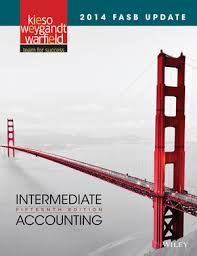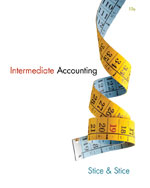Test Bank For Intermediate Accounting 15th Edition By Donald E.-Kieso
Original price was: $55.00.$19.00Current price is: $19.00.
Test Bank for Intermediate Accounting 15th Edition by Donald E. Kieso provides comprehensive coverage of intermediate accounting topics and a solid understanding of GAAP and its implications.
The text boasts a strong focus on conceptual understanding, problem-solving, and communication. Test Bank for Intermediate Accounting 15th Edition by Donald E. Kieso is an excellent resource for both students and practitioners alike.
Digital item No Waiting Time Instant Download
ISBN: 978-1118985328
Description
Test Bank For Intermediate Accounting 15th Edition By Donald E.-Kieso
CHAPTER 3
THE ACCOUNTING INFORMATION SYSTEM
IFRS questions are available at the end of this chapter.
TRUE/FALSE
Answer No. Description
F1.Recording transactions.
T2.Nominal accounts.
F3.Real (permanent) accounts.
F4.Internal event example.
F5.Liability and stockholders’ equity accounts.
F6.Debits and credits.
F7.Steps in accounting cycle.
T8.Purpose of trial balance.
T9.General journal.
F10.Posting and trial balance.
T11.Adjusting entries for prepayments.
T12.Example of accrued expense.
F13.Book value of depreciable assets.
T14.Reporting ending retained earnings.
F15.Post-closing trial balance.
F16.Posting closing entries.
T17.Closing entries and Income Summary.
F*18.Accrual basis accounting.
F*19.Purpose of reversing entries.
F*20.Adjusted trial balance.
Multiple Choice—Conceptual
Answer No. Description
d21.Purpose of an accounting system.
d22.Definition of posting.
d23.Purpose of an accounting system.
d24.Book of original entry.
d25.Purpose of trial balance.
d26.Identification of a real account.
b27.Identification of a temporary account.
a28.Temporary accounts.
c29.Double-entry accounting system.
c30.Double-entry system.
a31.Effect on stockholders’ equity.
a32.Transaction analysis.
a33.Accounting equation.
b34.Accounting process vs. accounting cycle.
d35.Accounting cycle steps.
d36.Criteria for recording events.
d37.Identification of a recordable event.
c38.Identification of internal events.
d39.External events.
d40.Limitations of trial balance.
a41.General journal.
b42.Journal entry.
c43.Journal entry.
d44.Journal entry.
d45.Imbalance in a trial balance.
d46.Purpose of unadjusted trial balance.
b47.Format of adjusting entry.
b48.Example of accrued expense.
d49.Accrual-basis of accounting.
c50.Accrued expense adjusting entry.
a51.Effect of not recording accrued expense.
b52.Description of a deferral.
d53.Effect of not recording accrued revenue.
a54.Effect of not recording depreciation expense.
a55.Timing of adjustments.
a56.Prepaid expense.
a57.Expiration of prepaid expenses.
b58.Effect of depreciation entry.
a59.Unearned revenue relationships.
a60.Computation of interest expense for adjusting entry.
d61.Purpose of adjusting entries.
c62.Matching principle.
a63.Prepaid items.
d64.Accrued items.
c 65. Definition of unearned revenue.
d 66. Definition of accrued expense.
c 67. Adjusting entry for accrued expense.
d 68. Factors to consider in estimating depreciation.
d 69. Adjusting entries.
d 70. Effect of adjusting entries.
b 71. Prepaid expense and the matching principle.
c 72. Accrued revenue and the matching principle.
b 73. Unearned revenue and the matching principle.
b 74. Adjusted trial balance.
c 75. Closing process.
c 76. Purpose of closing entries.
d 77. Cash collections vs. revenue recognized.
d *78. Cash-basis revenue.
c *79. Convert cash receipts to service revenue.
c *80. Convert cash paid for operating expenses.
c *81. Purpose of reversing entries.
d *82. Identification of reversing entries.
d *83. Identification of reversing entries.
b *84. Adjusting entries reversed.
d *85. Reporting inventory on a worksheet.
Multiple Choice—Computational
Answer No. Description
c 86. Effect of transactions on owners’ equity.
c 87. Effect of transactions on owners’ equity.
c 88. Unearned rent adjustment.
c 89. Unearned rent adjustment.
d 90. Determine adjusting entry.
c 91. Adjusting entry for bad debts.
b 92. Adjusting entry for bad debts.
c 93. Adjusting entry for interest receivable.
c 94. Subsequent period entry for interest.
d *95. Use of reversing entry.
d 96. Adjusting entry for unearned rent.
b 97. Adjusting entry for supplies.
d 98. Effect of closing entries.
b *99. Calculate cash received for interest.
b *100. Calculate cash paid for salaries.
d *101. Calculate cash paid for insurance.
c *102. Calculate insurance expense.
c *103. Calculate interest revenue.
c *104. Calculate salary expense.
d *105. Adjusting entry for supplies.
c *106. Reversing entries.
b *107. Unearned rent adjustment.
a *108. Determine adjusting entry.
d *109. Determine adjusting entry.
Multiple Choice—CPA Adapted
Answer No. Description
c110.Determine accrued interest payable.
b111.Determine balance of unearned revenues.
a112.Calculate subscriptions revenue.
c113.Determine interest receivable.
b114.Calculate balance of accrued payable.
b115.Calculate accrued salaries.
a116.Calculate royalty revenue.
d117.Calculate deferred revenue.
b*118.Difference between cash-basis and accrual method.
c*119.Determine cash-basis revenue.
b*120.Determine accrual-basis revenue.
a*121.Calculate cost of goods sold.
*This topic is dealt with in an Appendix to the chapter.





Be the first to review “Test Bank For Intermediate Accounting 15th Edition By Donald E.-Kieso”